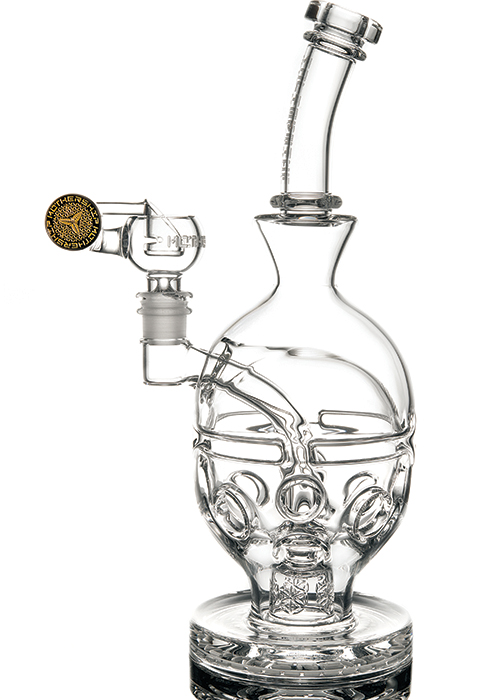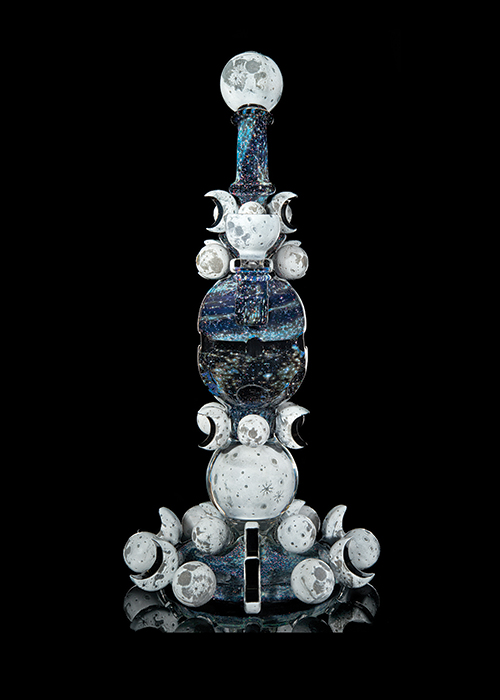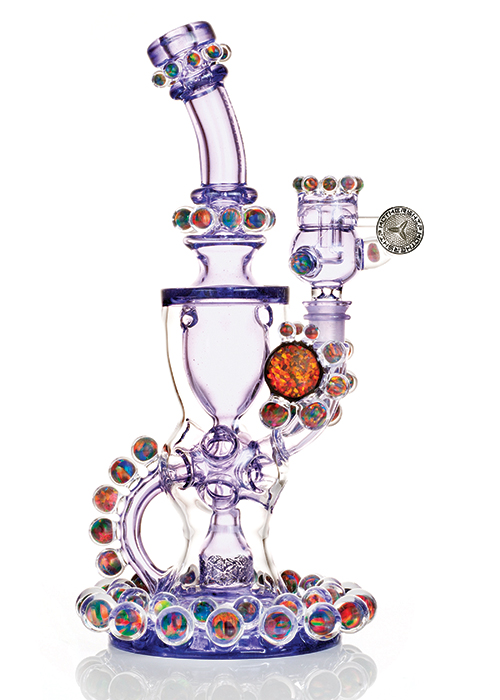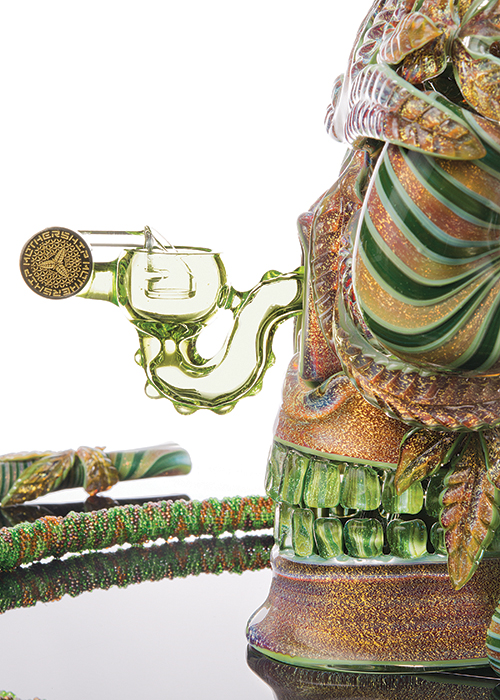
Few names have captured the imagination of scientific glass enthusiasts in recent years like the team of glassblowers at Mothership Glass.
Be it the beauty of their cutting-edge designs or the rips of such high quality they touch your soul every time, Mothership has been hitting home runs since they opened up shop in Washington state in 2013. Today, Mothership is the main force behind an entire glass subculture focused on purchasing and reselling pieces valued at as much as $200,000.
To get an idea of how the hype percolated since the first designs made shockwaves in the scientific glass community, we asked one of the top wholesale buyers of Motherships in the country what collectors are trying to get their hands on and discovered the origins of one of Mothership’s most iconic pieces from the main collaborator.
Ships at the Cave
Blake Hoffmann is a manager at The Cave in San Mateo, California, which, along with its newer sister location on the opposite side of the San Francisco Bay, is among the most famed high-end headshops in the galaxy. The Cave’s shelves are regularly lined with the absolute best wares from the top of the functional glass art food chain. The Cave was among the earliest places you could find Motherships on shelves — after their closest inner circle of shop buyers got first dibs.
In 2012, Scott Deppe and eventual Mothership co-owner Jake Colito produced the first Fab Egg. The Egg was essentially a 3D version of the Swiss Perc originally designed by glass blower Nate Dizzle. Hoffmann believes one of the biggest things that set Mothership off in the early days was the quality control Deppe already brought to his game. Even before kicking off the project, he was deeply respected for his past works, which tended to run for top dollar. At the time, Mothership worked with clear glass and whatever was produced using that glass had to meet Deppe’s high expectations.

“As a result of the cleanliness of Mothership pieces, even the very first ones stood out,” Hoffmann said. He also noted that if you put those early Kleins and Fab Eggs against the newest generations, those from the latter batch are a bit thicker and cleaner, but the originals remain exceptional.
Hoffmann has heard a Fab Egg is a 30-hour piece, and Mothership artists discard pieces that don’t make the quality control check every step of the way.
“Out of this 30-hour construction, you have ten different phases that are ten different pieces and each of those pieces could be one of three or five that made the grading to go into a first quality piece,” he said.
What artists look for includes seal integrity, symmetry and design-quality consistency. Every piece of a Mothership is instrumental to the entire work’s unique visual appeal, everything from the look and feel of the feet or base to the way the lips on the mouthpiece appear holds critical.
Functional Art
Another primary point of the hype is simply the way a Mothership rips. Hoffmann has owned four Motherships and, currently, his daily driver is an 8.4-inch Four Seed of Life perc system Egg. He said most elite designs in the glass game today are “a stemlessly designed piece that feeds into a direct diffuser or to a chamber that goes through some sort of diffusion.” The Fab Egg, Swiss Perc and Peyote Pillar all have a diffuser, and the design style creates a high- end, intense diffusion with thousands of little bubbles. Those bubbles get sent immediately into a natural diffusion design of some sort.
“It’s like taking a breath in,” Hoffmann said of the experience of dabbing off a Mothership piece. “I don’t feel as much like I have to milk it and clear it on a dab or flower rip. It’s more like hooking up a filter to your mouth and smoking through it.”
And The Cave has been plugged into the Mothership trend for quite some time.
“We’ve been carrying them since 2012 or 2013,” said Hoffmann. Back in those days, the original sticker price on the first Ships at The Cave ran between $1,000 and $1,500. Hoffmann noted some of the earliest stuff in Canadian shops was selling for as low as $600 or $700. Those first-generation models have tended to triple in value since first being made, according to Hoffmann, an increase driven by demand. This has sent their best work north of $200,000, with the cheapest first quality versions of their most famous models running a few thousand dollars.

Due to time restraints on what the glass artists could produce monthly, the secondhand market for their pieces quickly caught fire.
“The flip market really flipped them at an exceptionally high price,” Hoffmann said, adding that the glass also appealed to other types of cultural collectors. “You had sneakerheads getting into this that had experience in how to deal with exclusivity and maximize money on that. Mothership, of course, saw what the items were getting flipped for and they adjusted their retail prices over the years to kind of close that gap.”
Hoffmann recalled prospective buyers camping out for multiple nights at the shop prior to Mothership drops.
“You’d have a split between people that were intense fans of the brand… people in the culture that really wanted them for their personal collections and you had people that maybe wanted that, but also wanted a return on their investment when they heard they were selling for more on the flip than they were retail,” Hoffmann said.
But a third category of buyer, who had no interest in owning a Mothership, likely had the biggest impact in driving retail prices up: “You also had people that were going in saying, ‘OK, this is a hot item, it might be easy, I’m going to grab one and flip it the same day I buy it.’”
The Cave was able to paint a pretty clear picture of what happened after the drops. They would collect the Instagram accounts of the folks who came out so they could see where the pieces found their final destination. Hoffmann said Mothership would have seen the resale market happening in online auctions and didn’t want the end user to have to pay $1,500 for a piece they were only making $500 or $600 on.
“It was definitely an interesting situation where they were trying to raise prices to narrow the flip margin, so the people that wanted them would have to fight for them at the stores. The prices would only draw people that wanted to own them for a while, at least.”
Elites
Mothership’s most coveted works come in the form of their elite line. Elites tend to start in the $10,000 retail value range and offer various additional aesthetic features, from sandblasting to coldworked (the work that goes in after the piece has finished cooling) designs that could take longer to complete than the original production of the piece. Special lineups of single-color drops are also highly coveted. Mothership crafts their own fantastic colors, then offers only one of each model in that shade.
Among Mothership’s most famous works are their collabo- rations. Their Grateful Dead and Slop Cup efforts with the Japanese collective Team Japan blew minds, and the skull collaboration with Humboldt, California artist Mr. Gray is one of the most famous pieces of all time.

“It was an idea I had based on some pieces Scott [Deppe] had made,” Mr. Gray, the main artistic collaborator on the skull, said. “He had made a couple of versions, one of which was with Adam G [otherwise known as the “sweater kingpin”]… It was fashioned after that piece, which had more of a South American theme or look to it.”
Mr. Gray’s idea coincided with the first year of the PipeMasters Flame-Off, a collective event that brought numerous artists together to collaborate in 2013 at Nate Aweida’s 7 Point Studios, which was located in Seattle, Washington until spring 2017.
“I was not normally given the playing field where I would have the opportunity to collab with Scott Deppe,” Mr. Gray said. “I was only but acquaintances with him at the time.”
Mr. Gray ended up with Deppe’s number and decided to give him a call and pitched him on the project he would bring to PipeMasters for the two artists to create together. Deppe agreed. After a week of prep work with his then-assistant Ben David, Mr. Gray traveled to meet Deppe at PipeMasters.

After a five-day stretch of 16-hour work sessions, Mr. Gray and Deppe concluded the piece needed more work — Deppe apparently insisted on adding 30 more leaves. So, following a two-month hiatus, Mr. Gray headed up to Bellingham, Washington to Mothership with extra materials and spent over a week with Deppe, this time working 12-hour days. Finally, Mr. Gray’s family needed him back home, so he left the home-stretch to Deppe.
“Scott continued to work on it for another two weeks by himself,” Mr. Gray said. “I’m sure he had an employee helping him with it. It was a two-man job at that point. One person to hold the piece and another working on it. It was so big.”
Today the skull is ranked among the greatest pipes ever made.
“I feel like it’s residual, exponentially, trickling down still,” Mr. Gray said of the skull’s reception. “I got a lot of street credit from it, so I’m sure a lot of sales came from it.”
With such attention to detail and focus on quality, Motherships aren’t going anywhere. In fact, due to increased demand and faster production, there is a strong argument to be made that the epic pieces are more likely to be in the hands of collectors that love them right off the bat than ever before.
Source: CannabisNow.com





